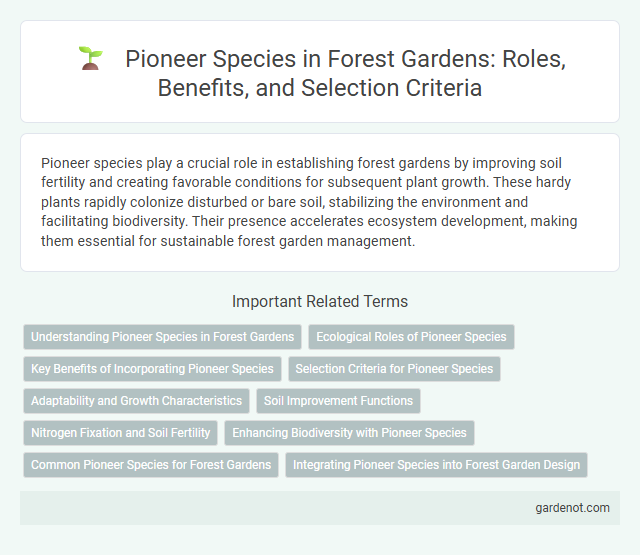Pioneer species play a crucial role in establishing forest gardens by improving soil fertility and creating favorable conditions for subsequent plant growth. These hardy plants rapidly colonize disturbed or bare soil, stabilizing the environment and facilitating biodiversity. Their presence accelerates ecosystem development, making them essential for sustainable forest garden management.
Understanding Pioneer Species in Forest Gardens
Pioneer species in forest gardens are hardy plants that establish quickly in disturbed or bare soil, improving soil fertility and microclimate for subsequent species. These plants enhance nitrogen fixation, prevent erosion, and provide shade, creating optimal conditions for slower-growing, economically valuable trees and shrubs. Recognizing the role of pioneer species accelerates forest garden succession and promotes sustainable, resilient ecosystem development.
Ecological Roles of Pioneer Species
Pioneer species in forest gardens play a critical ecological role by initiating soil formation and enhancing nutrient cycling through nitrogen fixation and organic matter accumulation. These hardy plants create favorable microclimates that facilitate the establishment of more diverse and complex plant communities. Their ability to stabilize soil prevents erosion, promotes biodiversity, and accelerates ecological succession toward mature forest ecosystems.
Key Benefits of Incorporating Pioneer Species
Pioneer species in forest gardens play a crucial role by rapidly improving soil quality through nitrogen fixation and organic matter accumulation, promoting nutrient cycling essential for subsequent plant growth. These species create microclimates that protect young plants from harsh environmental conditions, accelerating ecosystem development and biodiversity establishment. Their ability to stabilize soil and prevent erosion fosters a resilient and sustainable forest garden environment.
Selection Criteria for Pioneer Species
Pioneer species in forest gardens are selected based on rapid growth, nitrogen-fixing ability, and tolerance to poor soil conditions, ensuring quick soil improvement and habitat establishment. Key criteria include resilience to local climate extremes, minimal maintenance requirements, and the ability to support subsequent plant succession through soil stabilization and nutrient enhancement. Choosing species with deep root systems promotes soil aeration and water retention, crucial for fostering diverse ecosystems in early garden development stages.
Adaptability and Growth Characteristics
Pioneer species in forest gardens exhibit remarkable adaptability, thriving in poor soils and harsh conditions where other plants struggle to establish. These species typically have fast growth rates and strong root systems that improve soil quality and create a favorable microenvironment for subsequent plants. Their ability to fix nitrogen and tolerate varying light levels accelerates ecosystem development and biodiversity in the garden.
Soil Improvement Functions
Pioneer species play a crucial role in forest gardens by enhancing soil fertility through nitrogen fixation and organic matter accumulation. These hardy plants stabilize soil structure, increase microbial activity, and accelerate nutrient cycling, creating optimal conditions for subsequent plant communities. Their ability to improve soil aeration and water retention supports sustainable forest garden ecosystems and promotes long-term productivity.
Nitrogen Fixation and Soil Fertility
Pioneer species in forest gardens, such as alder and black locust, play a crucial role in nitrogen fixation by hosting symbiotic bacteria that convert atmospheric nitrogen into bioavailable forms. This process enhances soil fertility by increasing nitrogen content, which supports the growth of subsequent plant layers and improves overall ecosystem productivity. Incorporating nitrogen-fixing pioneer species accelerates soil development on degraded or barren land, promoting sustainable forest garden establishment.
Enhancing Biodiversity with Pioneer Species
Pioneer species play a crucial role in forest garden ecosystems by initiating soil improvement and creating habitats for diverse flora and fauna, thereby enhancing biodiversity. These hardy plants, such as nitrogen-fixing legumes and fast-growing shrubs, rapidly colonize disturbed areas, promoting nutrient cycling and microhabitat development. Their presence facilitates the establishment of successive plant layers, contributing to a resilient and multifunctional forest garden environment.
Common Pioneer Species for Forest Gardens
Common pioneer species for forest gardens include nitrogen-fixing plants like alder (Alnus glutinosa) and black locust (Robinia pseudoacacia), which improve soil fertility by enriching nitrogen levels. Fast-growing shrubs such as sea buckthorn (Hippophae rhamnoides) provide early canopy cover and protect young plants from wind and erosion. These species establish microclimates and enhance biodiversity, creating favorable conditions for slower-growing, shade-tolerant crops and trees in a forest garden ecosystem.
Integrating Pioneer Species into Forest Garden Design
Integrating pioneer species into forest garden design accelerates ecosystem development by improving soil fertility and providing early shade for shade-tolerant plants. Fast-growing nitrogen-fixing trees like Alnus and Robinia enhance soil nutrients, creating a favorable microclimate for successive species. Strategic placement of pioneers supports biodiversity, stabilizes soil, and establishes a multilayered canopy essential for a resilient forest garden system.
Pioneer species Infographic

 gardenot.com
gardenot.com